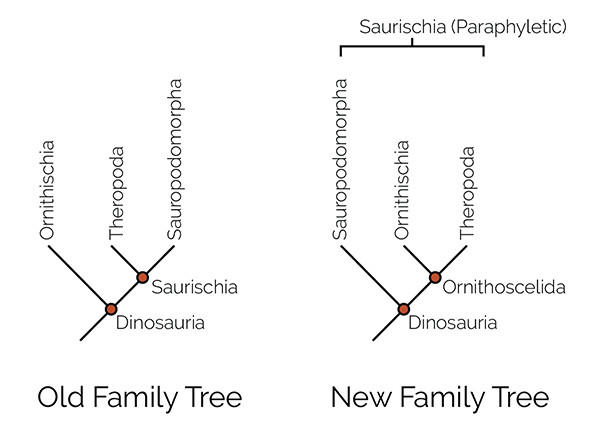
by Mary Caperton Morton Friday, June 16, 2017

The old (left) and new (right) dinosaur family trees. Credit: K. Cantner, AGI, after Baron et al., Nature, March 2017.
Dinosaurs have long been grouped into two major clades — Ornithischia and Saurischia — largely based on the shapes of their hips. But new phylogenetic research is shaking up the dinosaur family tree, suggesting the traditional two-branch system needs reorganizing.
Under the two-branch system, originally proposed in 1888, dinosaurs are either “bird-hipped” ornithischians or “reptile-hipped” saurischians. Ornithischians include mainly herbivores, such as stegosaurs and duckbilled hadrosaurs; the saurischians are divided into carnivorous theropods (which, despite their reptilian hips, would later evolve into birds) such as Tyrannosaurus rex, and the long-necked, long-tailed herbivorous sauropods, such as Diplodocus.
However, a new phylogenetic analysis, led by Matthew Baron of the University of Cambridge in England and London’s Natural History Museum, found that the ornithischians should be grouped with the theropods, creating a new group called the Ornithoscelida that excludes the sauropods. The regrouping helps explain why birds evolved from supposedly reptile-hipped dinosaurs: Both ornithischians and theropods eventually evolved a bird-like hip arrangement, but they did so at different times in their evolutionary history, with the theropods becoming bird-hipped later, as they transitioned into birds, the team wrote in Nature.
“The repercussions of this research are both surprising and profound,” said co-author David Norman, also of the University of Cambridge, in a statement. “The bird-hipped dinosaurs, so often considered paradoxically named because they appeared to have nothing to do with bird origins, are now firmly attached to the ancestry of living birds.”
© 2008-2021. All rights reserved. Any copying, redistribution or retransmission of any of the contents of this service without the expressed written permission of the American Geosciences Institute is expressly prohibited. Click here for all copyright requests.